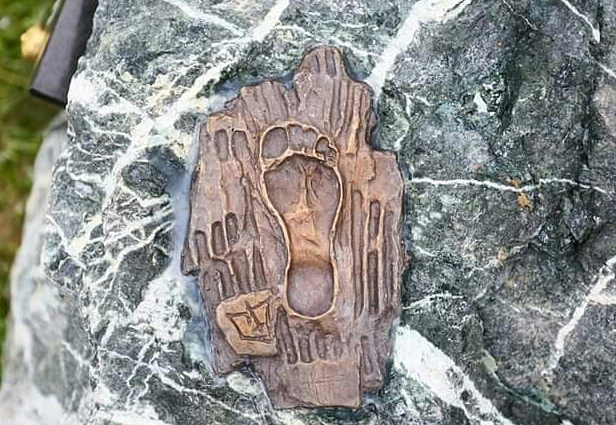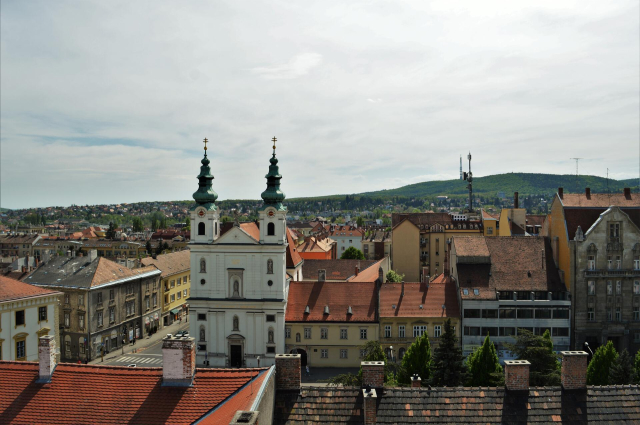
( Day 6) Sopron - Kőszeg

The medieval downtowns of both Sopron and Kőszeg are extremely rich in medieval monuments, churches, and residential buildings, which determine their atmosphere. Walking along their winding, cobbled streets, the doorways, colourful houses, and courtyards hide and tell many stories. On the 5th day, we will get to know the legend of the construction of the Goat Church, as it is called in everyday language, as well as Sopron's oldest street, which is called Új utca (New Street) nowadays. The Kőszeg mountains beckon us as we pass through vineyards, wooded and hilly areas, all the way along the footprints of St. Martin.
In the heart of the city centre, in Fő tér, we find the Gothic Goat Church. Architecturally, the church was influenced by the styles of several periods, including Gothic and Baroque. This duality can be observed in many areas in the church, on the guardian stones decorated with leaves or distorted human heads, on the beautiful vault or on the delicate stone lattices.
LEGEND
"According to legend, the slender tower of the church was built from Turkish treasury riches, dug out by a goat, but in reality, there is a murder case behind it. One of the perpetrators of János Büki's murder was Henrik Geissel (Hungarian: Kecskés), who donated the money for the construction of the church tower as penance for himself or his family." (visitsopron)
The church was the scene of many historical events: King Ferdinand III and two Hungarian queens were crowned, as well as five parliaments were held here. According to the legend, St. John of Capistran also preached here.
Sopron
Spiritual provision
 |
Saint John of Capistrano used preach in this place. That Italian Franciscan monk to whom we Hungarians owe so much. One of the great heroes of the Nándorfehérvár triumph. In 1456, even though they had heard the news of the Turkish advance, the governors did not gather an army, even though the papal envoy warned them in vain. However, Mihály Szilágyi remained in the fortress of Fehérvár with barely 5-7 thousand men, a ridiculously small army compared to the Turkish army. He said that even if we all die, we would protect our women, our children, and our country. After that, János Hunyadi collected some reinforcements and entered - not easily - the besieged castle. But that would not have been enough to win. The large army; about 35,000 people, was collected by the preaching of Saint John of Capistrano (and he didn't even speak Hungarian). They weren't soldiers. Fathers, youths, husbands and brothers. This is how we were able to win there, and thus the Turkish conquest only took place about 80 years later. When the Turks invaded Hungary, during the Battle of Mohács, approx. 4 million Hungarians lived in the Carpathian Basin. When the Turks were defeated, there were only approx. 2 million. According to many, the great miracle of history is that we were still able to get back on our feet, that the Hungarian people rose again.
Bow your head before the great Franciscan monk! What do you put on the common table of the nation - not because it is paid for, not because it is applauded, but out of a sense of responsibility and generosity? |
Goat church |
The city still has surprises in store for us, Új utca (New Street) opening from the main square is actually the oldest part of the city. The Gothic Old Synagogue, unique in Central Europe, hides here among the houses. The Jews living here were not rich, according to the first written records, their first church was built in the city at the end of the 12th century, which was a house of prayer, an assembly hall and also a school. After its renovation, we can see the community's former hospital and the ritual bath, both in their old condition.
Sopron
Spiritual provision
 |
How much humanity owes to the Bible, and thus to the people of the Bible! The realization of the one, invisible, personal, creative God, the pure moral consciousness of the ten commandments, the seventh day of rest, the hope proclaimed by the prophets, the Savior prophesied by them.
Do I know the Book of Books? Am I passing this treasure to my children and grandchildren as the most important heritage of humanity? |
Gothic Old Synagogue |
Riding our bicycles in the southern direction, following the EuroVelo 13 sign, we move away from Sopron towards Harka.
Have you heard the legend of Kékfrankos? (Lemberger/Franconia)
In 1809, Napoleon's soldiers were housed in the city. The soldiers loved the good Sopron wine so much that they often bought it with their own money in addition to the provisions. Soldiers had two types of money: the wartime white Franc and the more valuable old blue Franc. The scrupulous winegrowers only sold their best wines if they received the best money in exchange for them. When it was time to pay, the soldiers were told: "Blue Francs!" Since then, Sopron's famous red wine has been called kékfrankos (bluefranc). The only flaw in the story is that at that time, mostly white wine was produced in the area "
Riding through the former border guard settlement, we head towards the Austrian border, Neckenmarkt (Nyék). On the Austrian side, we are also greeted by the hilly countryside dotted with vineyards and forested areas. Crossing the Hungarian border again at Ólmod, then turning left at Horvátzsidány, we stop for a longer rest. Approaching the forested part of the village, we can find the Mária Peruška Shrine, which is located in a clearing near the border of 4 villages (Kőszeg, Horvátzsidány, Kiszsidány and Peresznye).
Horvátzsidány
Spiritual provision
 |
A three-year-old child went missing and was found - three days later - in this place. Since then, people have been coming here to give thanks and pray. What a great treasure a child is! How many beautiful talents and possibilities the Creator has hidden in every little human heart!
A child is primarily not raised by words, but by the character of his parents. What the parent is like radiates into the child. The most fundamental thing in a parent's life that affects their children is the love of the two parents for each other, their relationship. It defines the basic atmosphere of a home. This is a child's first experience of the world and life. If the child sees that things can be said, the other person understands, even if something goes wrong it is not a tragedy, it can be forgiven, it can be smiled upon, if he sees that his parents are happy, then the child's soul opens up. He feels that the world is beautiful and it is worth living. If a child has to experience that it is in vain to say anything, the other one does not even understand it, everyone here has huge convulsions, everything is swept under the carpet, the parents are unhappy, then the child also becomes convulsed and scared. An old saying, but very true: A father loves his children best when he loves their children's mother, and a mother loves her children best when she loves their children's father.
What radiates from your being towards your children, those entrusted to you? Nervousness, confusion, bitterness? Or peace and goodwill, a cheerful and open heart? |
The Shrine of Mária Peruska |
We only have a few kilometres to go from today's journey, and we arrive at Kőszeg, surrounded by protected forests, next to the former Iron Curtain. On the way, we can stop at many places and, if we want, we can taste the local flavours (e.g. pumpkin-poppy cake, dödölle, etc.)
- Duration: 3 hour(s)
- Length: 55,3 km
- Difficulty: Medium
| Area: | Velo Martini |
| Típus: | Cycling routes |
Szolgáltatás Stop point
Stop point- Sopron - Church of the Assumption (Goat Church)
Sopron - Nagyboldogasszony templom (Kecske templom)The Franciscan monks first built their monastery, then around 1280 they built a church next to it, which is an outstanding work...
MoreStop point - Sopron
Sopron - ÓzsinagógaThe former synagogue stands in the courtyards of two late medieval buildings in the city centre. The first written records of...
MoreStop point- Kőszeg - Church of the Heart of Jesus
Kőszeg - Jézus szíve templomThe Parish Church of the Heart of Jesus stands in the historic centre of Kőszeg, where the Castle Circle and the market square...
MoreStop point - Kőszegdoroszló
KőszegdoroszlóThe church of St Martin is probably of Romanesque origin, but the exact date of its construction is unknown. It was used for a...
MorePoint of interest - Kőszeg - Bronze footprint of Saint Martin
Kőszeg - Szent Márton Bronz lábnyomaIn November 2019, the St. Martin Memorial was inaugurated next to the St. Martin tree in Hunyadi Mátyás Park in Kőszeg. King...
MorePoint of interest - Horvátzsidány - Chapel of Mary Péruska
Horvátzsidány - Péruska Mária KápolnaMary of Peruška is a popular place for hikers and pilgrims. In 1994, a small chapel was built near the oak tree in honour of St....
MorePoint of interest - Old synagogue
Sopron - ÓzsinagógaThe former synagogue stands in the courtyards of two late medieval buildings in the city centre.The first written records of the...
MorePoint of interest-Sopron - Church of St. Michael
Sopron - Szent Mihály-templomSt Michael's Church is the oldest parish church in Sopron. It is located on a very important traffic route in the...
MorePoint of interest -Sopron - Church of the Holy Spirit
Sopron - Szentlélek-templomThe first authentic mention of the church, which is Gothic on the outside and Baroque on the inside, dates back to 1406. It was...
MorePoint of interest - Sopron - Church of Saint George
Sopron - Szent György-templomAccording to the medieval story, János Schmuckenpfennig, a citizen of Sopron, was involved in a murder.
MorePoint of interest -Sopron - Church of the Immaculate Conception (orsolyte)
Sopron - Szeplőtelen Fogantatás (orsolyita) templomThe convent of the Order of St. Orsolya in Sopron was founded in 1746 by the Viennese woman Mária Niggl.
MorePoint of interest - Sopron - Church of St. Jude of Tade (Dominican)
Sopron - Szent Júdás Tádé (domonkos) templomThe Dominicans were settled in Sopron in 1674 by Countess Erzsébet Batthyány.
MorePoint of interest - Sopron - Lutheran Church
Sopron - Evangélikus templomThe Lutheran Church of Sopron is located in the centre of the city, in the middle of Templom Street, near the junction of...
More






















